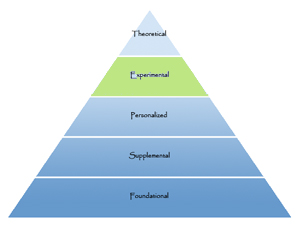Anti-Aging - Experimental

But we’re not talking about dangerous pharmaceutical drugs. There are many natural therapies for which safety can be inferred through the collective results of clinical trials, similar treatments, compelling science or anecdotal, and even successful animal experiments. Personally, I’m ok with experimenting a little on myself by taking smart risks, and not waiting 2 generations before deciding if something is 100% safe (we won’t be around long enough to find out!). What I’m talking about here are cutting edge findings and therapies that can have enormous healing power. I’ll introduce several concepts in this post that fit that description.
Stem cell treatments are straddling that line between conventional therapies and cutting edge. Conventional, because there are actually 40+ years of documented studies for certain stem cell therapies. It’s by far the most suitable treatment for repair of ligaments, tendons, joints, osteoarthritis, cardiovascular, and a few others. Placenta-cord banking is also becoming commonplace. Cutting edge, because medicine is pushing the bounds of what we can do with stem cells. I hear of remarkable stories all the time that sound more like science fiction. I’ve undergone a stem cell treatment myself which was tailored more to general repair and anti-aging. The results are encouraging, but time will tell how effective it was. Stem cell therapies are done using your own stem cells. Treatments involving fetal stem cells are both illegal and unproven.
Lectins are a damaging type of protein found in many food sources – especially in certain fruits, vegetables, and legumes. Their significance in health isn’t fully embraced in medical circles, but it IS something that’s been recognized by the scientific community and Dr D’Adamo – author of the Blood Type Diet. These things have a way of latching onto your organs and plugging up your plumbing. They cause your blood to cluster up if your blood type isn’t compatible with it. It’s something that tends to manifest itself in the longer term. But we’re interested in anti-aging and not taking any chances! Adding a lectin blocker supplement to your regimen will help protect you from lectins. You can also learn more about and avoid those incompatible foods by picking up the book on Genotype Diet/ Blood Type Diet.
Telomeres are perhaps the best judge of a person’s biological age. The longer they are, the more youthful a person is overall. With today’s science there are definitely certain things that are known to prevent the shortening of telomeres. These include carnosine, healthy estrogen levels for women, and human growth hormone (HGH) levels in men. Undergoing treatments to lengthen telomeres is a different story. I did test a supplement called TA-65 that was supposed to do just that. However at the end of the treatment, my telomere lengths did not increase. Suffice to say, at least it didn’t deteriorate in that 9 month span. This is not an appreciable result for an expensive product such as TA-65. However, it should be noted this product is supposed to be used by people 40 and over. While I’m in that ballpark, I have the telomere length of a 26 year old. So perhaps I will give it another shot in 15 biological years or so. But for now, I’ll have to conclude there is no effective means to lengthen telomeres. The best advice I can give you at this time is to supplement with carnosine, exercise to boost growth hormone levels, and avoid chemicals in your food and other products which will damage your DNA.